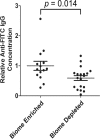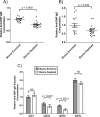Increased biodiversity in the environment improves the humoral response of rats
- PMID: 25853852
- PMCID: PMC4390306
- DOI: 10.1371/journal.pone.0120255
Increased biodiversity in the environment improves the humoral response of rats
Abstract
Previous studies have compared the immune systems of wild and of laboratory rodents in an effort to determine how laboratory rodents differ from their naturally occurring relatives. This comparison serves as an indicator of what sorts of changes might exist between modern humans living in Western culture compared to our hunter-gatherer ancestors. However, immunological experiments on wild-caught animals are difficult and potentially confounded by increased levels of stress in the captive animals. In this study, the humoral immune responses of laboratory rats in a traditional laboratory environment and in an environment with enriched biodiversity were examined following immunization with a panel of antigens. Biodiversity enrichment included colonization of the laboratory animals with helminths and co-housing the laboratory animals with wild-caught rats. Increased biodiversity did not apparently affect the IgE response to peanut antigens following immunization with those antigens. However, animals housed in the enriched biodiversity setting demonstrated an increased mean humoral response to T-independent and T-dependent antigens and increased levels of "natural" antibodies directed at a xenogeneic protein and at an autologous tissue extract that were not used as immunogens.
Conflict of interest statement
Figures







Similar articles
-
Characterization of the adaptive immune response following immunization in pregnant sows (Sus scrofa) kept in two different housing systems.J Anim Sci. 2014 Aug;92(8):3388-97. doi: 10.2527/jas.2013-7531. Epub 2014 Jun 19. J Anim Sci. 2014. PMID: 24948651
-
In vivo and in vitro humoral immunity in surgical patients: antibody response to pneumococcal polysaccharide.Surgery. 1986 Aug;100(2):229-38. Surgery. 1986. PMID: 3488597
-
Humoral immune responses in L-selectin-deficient mice.J Immunol. 1996 Dec 1;157(11):4899-907. J Immunol. 1996. PMID: 8943394
-
Routes of immunization and antigen delivery systems for optimal mucosal immune responses in humans.Behring Inst Mitt. 1997 Feb;(98):33-43. Behring Inst Mitt. 1997. PMID: 9382757 Review.
-
Key concepts in immunology.Vaccine. 2010 Aug 31;28 Suppl 3:C2-13. doi: 10.1016/j.vaccine.2010.07.022. Vaccine. 2010. PMID: 20713253 Review.
Cited by
-
Protein profiles of hatchery egg shell membrane.Proteome Sci. 2017 Mar 3;15:4. doi: 10.1186/s12953-017-0112-6. eCollection 2016. Proteome Sci. 2017. PMID: 28270742 Free PMC article.
-
Immunization enhances the natural antibody repertoire.EXCLI J. 2017 Jul 10;16:1018-1030. doi: 10.17179/excli2017-500. eCollection 2017. EXCLI J. 2017. PMID: 28900382 Free PMC article.
-
Following Natural Autoantibodies: Further Immunoserological Evidence Regarding Their Silent Plasticity and Engagement in Immune Activation.Int J Mol Sci. 2023 Oct 6;24(19):14961. doi: 10.3390/ijms241914961. Int J Mol Sci. 2023. PMID: 37834409 Free PMC article.
-
Depletion of MHC supertype during domestication can compromise immunocompetence.Mol Ecol. 2021 Feb;30(3):736-746. doi: 10.1111/mec.15763. Epub 2020 Dec 22. Mol Ecol. 2021. PMID: 33274493 Free PMC article.
-
Nutritional Supplement of Hatchery Eggshell Membrane Improves Poultry Performance and Provides Resistance against Endotoxin Stress.PLoS One. 2016 Jul 27;11(7):e0159433. doi: 10.1371/journal.pone.0159433. eCollection 2016. PLoS One. 2016. PMID: 27463239 Free PMC article.
References
-
- Lesher A, Li B, Whitt P, Newton N, Devalapalli AP, Shieh K, et al. Increased IL-4 Production and Attenuated Proliferative and Proinflammatory Responses of Splenocytes from Wild-Caught Rats (Rattus Norvegicus). Immunol Cell Biol. 2006;84:374–82. - PubMed
-
- Lin SS, Holzknecht ZE, Trama AM, Everett ML, Thomas AD, Su KY, et al. Immune characterization of wild-caught Rattus norvegicus suggests diversity of immune activity in biome-normal environments. Journal of Evolutionary Medicine. 2012;1:1–16.
-
- Devalapalli AP, Lesher A, Shieh K, Solow JS, Everett ML, Edala AS, et al. Increased Levels of IgE and Autoreactive, Polyreactive IgG in Wild Rodents: Implications for the Hygiene Hypothesis. Scand J Immunol. 2006;64:125–36. - PubMed
Publication types
MeSH terms
Substances
LinkOut - more resources
Full Text Sources
Other Literature Sources

